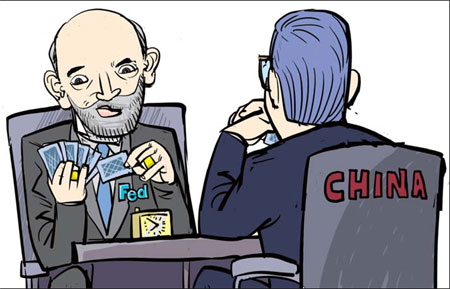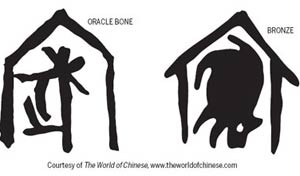China is the unseen card in Fed policy
Updated: 2011-10-07 10:11
By Eugene Y. Lee (China Daily)
|
|||||||||
|
Zhang Chengliang / China Daily |
The US central bank is making provisions for a Chinese retreat on treasury bonds
A few weeks ago the US Federal Reserve announced a measure to bolster the country's economy. It was the so-called operation twist, in which an attempt was made to raise short-term interest rates and lower long-term interest rates simultaneously by buying long-term treasury bonds and selling short-term bonds.
The Fed had not used this monetary tool for 50 years. Operation twist is originally from the card game pontoon. You have the option to stick (keep the hand you are holding) or twist (draw another card). What has made the Fed change its strategy from stick to twist, changing the composition of the government bonds it holds?
Economists proffered a variety of reasons: the stubbornly high unemployment rate, the slowdown in the growth of real GDP, and the $1.28 trillion budget deficit projected for this year, 8.5 percent of US GDP, nearly four years after the downturn began.
Few, if any, economists mentioned the China factor in the Fed's decision: the Fed is trying to regain its control over long-term interest rates and to keep bond interest rates lower in case China stops buying US treasury bonds.
It is true that the US economy continues to struggle but the Fed has a number of conventional tools available: 1) changing the reserve requirement; 2) changing the discount rate; 3) open market operations. Using these tools, the Fed can influence the demand and supply of the balance of depository institutions' reserves and thus the federal funds rate. Once the federal funds rate changes, a chain of events is triggered and the whole market's short-term interest rates are changed. Ultimately, the impact would be expected to pass to the rates of unemployment, inflation and to GDP.
In the past these conventional tools have been effective in controlling short-term interest rates. The last 10 years show that the US short-term rate was effectively controlled by the Fed and the manipulated range was from near zero percent to about 5 percent. The Fed's operation successfully achieved one of its intermediate aims, manipulating short-term rates as a policy goal, but it missed its ultimate monetary policy aims: achieving the best combination of low inflation, low unemployment, rapid GDP growth, and orderly financial markets.
In addition, the conventional tools predominantly used have been exhausted, and the federal funds rate is now between 0 percent and .25 percent.
The Fed's conventional tools were not - and may not be - effective in a changed environment where China has become the second largest economy after the US and the largest foreign holder of US securities. According to the latest Treasury survey of US securities portfolios, China's total holdings in July were $1,173.5 billion. Long-term US securities debt and long-term US Treasury securities are the largest category of China's holdings of US securities.
From 2004 to 2008 China's holdings of US long-term securities more than tripled, from $341 billion to $1,205 billion. In the same period the US long-term interest rate fell from from 5.5 percent to about 4 percent. Alan Greenspan, the former Federal Reserve chairman, once confessed in the Wall Street Journal that China's growth and its purchase of the US securities made the Fed helpless in controlling the long-term US interest rate.
Greenspan's argument may have been a self-serving exercise in blame shifting, but his remarks reflected, to some degree, the fact that China had an impact on US long-term interest rates. The optional twist of Greenspan's successor, Ben Bernanke, came while China had steadily reduced its holdings of US securities.
Many economists believe that stabilizing the housing market is the key to US economic recovery. To boost the housing market, the Fed faces a number of challenges.
The first is rates, and two scenarios exist. Scenario 1: When China buys a large number of US long-term securities and the US mortgage market is already too hot, does the Fed have the ability to raise the long-term rate to cool the market? Scenario 2: When China sells US long-term securities and the US is in recession, can the Fed successfully lower the long-term interest rate.
We may already know the answer for scenario 1. The Fed failed in dealing with the challenge during the housing bubble from 2003 to 2006, either because it did not take proper action or because the actions it did take failed. For scenario 2, we do not know the results yet. The last time the Fed tried something similar was 50 years ago, when it managed to lower long-term rates by only 0.15 of a percentage point. That is the estimated effect according to some economists. In a 2004 paper, Bernanke played down the strategy's significance as a tool for promoting lower long-term rates.
The second challenge for the Fed is the so-called liquidity trap, in which monetary policy is unable to stimulate an economy, either through lowering interest rates or increasing the money supply. At present unemployment is still high, households are struggling to pay off debt and most banks are refusing mortgage applications. Bernanke could buy more bonds across the board to depress long-term interest rates, but given the present situation, whatever the interest rate, it is unlikely that the operation twist alone would make much of a difference.
A fast and significant decrease of China's holdings of US securities would not be in the best interests of China and the US. For the US, its long-term interest rates are tied to US Treasury yields, which are determined by supply and demand of treasuries. These are initially sold at auction by the Treasury Department. If demand is high, the treasury yields decrease; if demand is low, the treasury yields increase.
If China, the foreign holder, buys fewer treasuries and Bernanke's optional twist fails, Treasury yields will increase. As the yields increase, so do long-term interest rates (including fixed-rate mortgage rates). This makes it more expensive to buy homes, so demand for them falls, as do house prices. The savings of the average American are not in banks but in their house. Falling house prices would restrict consumption, which can slow GDP growth and wipe out economic recovery.
For China, a sudden deduction of its holdings of US securities could be a nightmare. It has accumulated these huge savings largely from its exports of labor intensive goods, not from high-tech or high value-added products. These savings have been accumulated thanks to the hard work of millions of Chinese on wages well below the US standard. Because of China's dominant share of US securities, a large sell-off would move the international market.
China would face triple losses: direct, indirect and induced. Direct losses would be the result of price losses for what China sells. China bought Treasuries expensively in times of high demand and would be selling them cheaply at a time of high supply. Indirect losses would be the result of value lost for what China is not selling (China's remaining securities) and because of dollar depreciation due to China's sell-off. Induced losses would be the result of falls in Chinese exports as a result of US economic recovery being put back. If the US greatly reduced imports from China, China's manufacturing would suffer significantly.
Both countries need time to reform their economies. The US should boost its level of savings. China should adopt polices that promote its domestic demand as a major source of its growth. Before this restructuring occurs, the US needs China's support for its financial rescue plan and economic stimulus package while China needs the US market for its exports.
The author is an associate professor with University of Maryland University College. The opinions expressed in the article do not necessarily reflect those of China Daily.












